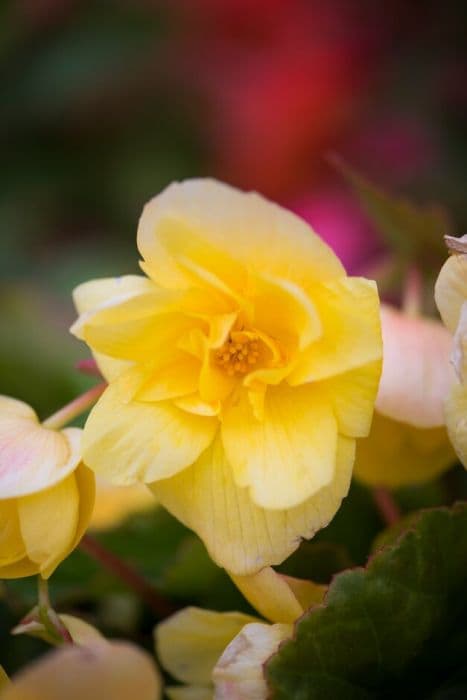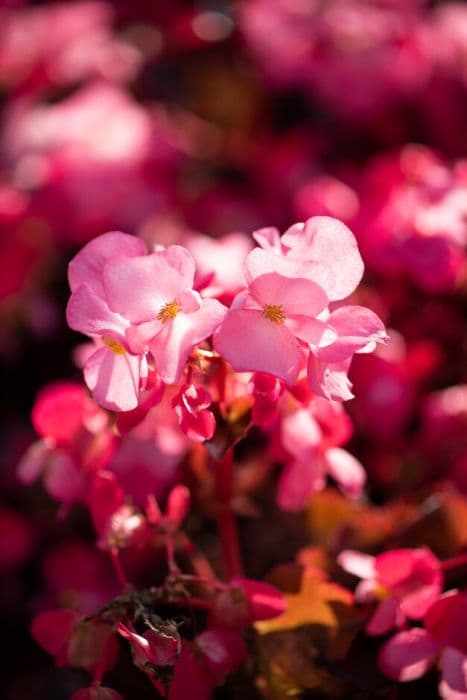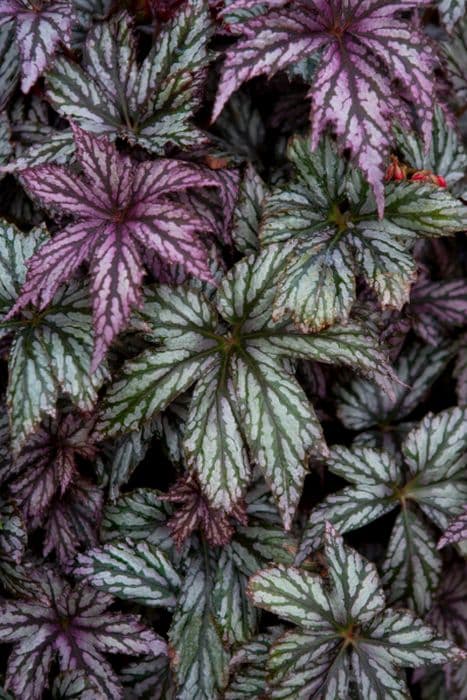Wax Begonia Begonia 'Pin Up' (T)

ABOUT
Begonia 'Pin Up' is a cultivated variety known for its distinctive foliage and flowers. The leaves of this plant exhibit a textured appearance with a combination of green and often red or burgundy hues, sometimes with a metallic sheen. The leaf shape is typically asymmetrical, with a heart-like form that tapers to a point. The edges of the leaves may be gently serrated or scalloped, adding to their visual interest. The flowers of Begonia 'Pin Up' add a burst of color with their bright and showy nature. They usually come in clusters, displaying shades that can range from soft pinks to vibrant reds, sometimes with a mix of white or lighter colors. The blooms are delicately layered with petals that can look either waxy or velvety, creating a lush, tropical look. Overall, Begonia 'Pin Up' is an attractive ornamental plant prized for its ornate leaves and eye-catching flowers, which contribute to its popularity in decorative gardening and as a houseplant.
About this plant
 Names
NamesFamily
Begoniaceae
Synonyms
Tropical begonia, Begonia 'Pin Up'
Common names
Begonia 'Pin Up'
 Toxicity
ToxicityTo humans
The Begonia plant is generally considered non-toxic to humans. However, some people may have a mild allergic reaction if they come into contact with the sap of Begonia or if they ingest parts of the plant. Reactions can include irritation of the skin, mouth, throat, and gastrointestinal tract, which may cause symptoms such as redness, swelling, a burning sensation, vomiting, and diarrhea. Typically, these symptoms are not severe, but if someone were to consume a large quantity of the plant or has a severe reaction, it is recommended to seek medical attention.
To pets
Begonias are considered toxic to pets, particularly dogs and cats. If a pet ingests part of a Begonia plant, symptoms of poisoning may include vomiting, salivation, and difficulty swallowing due to irritation of the oral cavity. In more serious cases, the pet may experience kidney failure. If you suspect your pet has ingested Begonia, it is important to contact a veterinarian immediately.
 Characteristics
CharacteristicsLife cycle
Perennials
Foliage type
Evergreen
Color of leaves
Variegated
Flower color
Varies
Height
1-2 feet (30-60 cm)
Spread
1-2 feet (30-60 cm)
Plant type
Herbaceous
Hardiness zones
10
Native area
Tropical South America
Benefits
 General Benefits
General Benefits- Decorative appeal: Begonia 'Pin Up' has vibrant foliage and colorful flowers that add visual interest to indoor and outdoor spaces.
- Easy to grow: This variety of begonia is known for being relatively low-maintenance and easy to care for, making it suitable for gardeners of all skill levels.
- Versatility: It can be planted in containers, hanging baskets, or garden beds, offering flexibility in garden design and space utilization.
- Long blooming period: It provides a long season of color, usually blooming from late spring to early fall, depending on the climate.
- Attracts pollinators: When planted outdoors, the flowers can attract beneficial pollinators such as bees and butterflies.
- Drought tolerance: Once established, it is somewhat drought-tolerant, requiring less frequent watering than some other plants.
 Medical Properties
Medical PropertiesThis plant is not used for medical purposes.
 Air-purifying Qualities
Air-purifying QualitiesThis plant is not specifically known for air purifying qualities.
 Other Uses
Other Uses- Begonia 'Pin Up' can be used in terrariums for its ability to thrive in high humidity and filtered light, adding a splash of color to miniature indoor landscapes.
- The plant serves as inspiration for artists and photographers due to its unique foliage and bright flowers, often becoming a subject in botanical illustrations and garden photography.
- Begonias can be used in educational settings, like schools or botanical workshops, to teach about plant propagation through leaf cuttings, as they root easily and demonstrate plant growth processes clearly.
- It's often integrated into Feng Shui practices by placing it in areas that require energy movement or a burst of color to balance the space's chi.
- Their vibrant flowers sometimes influence interior design color schemes, where decorators take cues for fabrics and paints to create a coherent visual flow in a room.
- The attractive foliage of Begonia 'Pin Up' can be used as a natural table centerpiece for special events or gatherings, adding a touch of elegance without the need for cut flowers.
- It can be a source of inspiration for fashion designers, where the color and pattern of the foliage and flowers influence textures and print designs in the fashion industry.
- Begonias can act as a natural deterrent for some pests in the garden, making them useful companion plants for a variety of vegetables and herbs.
- They are used in rituals and celebrations, where plants and flowers have symbolic meanings, like conveying gratitude or affection in certain cultures.
- Children's educational kits sometimes include Begonia 'Pin Up', as the colorful, fast-growing plant can stimulate interest in horticulture and botany among young learners.
Interesting Facts
 Feng Shui
Feng ShuiThe Begonia is not used in Feng Shui practice.
 Zodiac Sign Compitability
Zodiac Sign CompitabilityThe Begonia is not used in astrology practice.
 Plant Symbolism
Plant Symbolism- Caution - Begonia often represents caution or a warning to be careful, reflecting perhaps the delicate nature of the plant's blooms and the need for careful handling.
- Uniqueness - The variety 'Pin Up' showcases the unique patterns and colors of its flowers, symbolizing individuality and the beauty of being different.
- Balance - With their asymmetrical appearance yet harmonious look, begonias can symbolize balance and finding equilibrium in different aspects of life.
- Harmony - The overall aesthetic of the plant promotes a sense of harmony and peace, making it a great gift for wishing well in relationships and home life.
- Gratitude - In some cultural contexts, giving a begonia can express gratitude or appreciation, a symbol of thanks for support or kindness received.
 Water
WaterBegonia 'Pin Up' should be watered thoroughly when the top inch of soil feels dry to the touch, which typically equates to watering once a week; however, this frequency can vary depending on environmental conditions. It's essential to avoid soggy soil, so apply enough water so that it runs through the drainage holes—usually about 16 ounces for a standard pot. During the active growing season, spring and summer, they might need more frequent watering, whereas in the winter, water requirements usually decrease.
 Light
LightBegonia 'Pin Up' flourishes in bright, indirect light but must be protected from direct sunlight, which can scorch its leaves. An ideal spot would be a few feet away from a sunny window, where the plant can receive plenty of light without being under the harsh midday sun. If the light is too low, the plant will show signs of legginess and fewer blooms.
 Temperature
TemperatureBegonia 'Pin Up' prefers to be kept in a temperature range of 60 to 75 degrees Fahrenheit. It can tolerate a minimum temperature of 50 degrees Fahrenheit but should not be exposed to temperatures below this, as cold drafts can harm the plant. Maintain a warm and stable environment to encourage healthy growth and continuous flowering.
 Pruning
PruningPruning your Begonia 'Pin Up' is essential to remove dead or yellowing leaves and to encourage bushier growth, which can be done as needed throughout the year. The best time to prune is in the spring before the onset of the active growing season. Lightly pinch back new growth to promote branching and cut back any leggy stems to maintain an attractive shape.
 Cleaning
CleaningAs needed
 Soil
SoilThe best soil mix for Begonia 'Pin Up' is light, well-draining, and rich in organic matter, such as a combination of peat, perlite, and compost. Preferred pH for this plant ranges from 5.5 to 6.5.
 Repotting
RepottingBegonias like 'Pin Up' should be repotted every 1-2 years or when the plant outgrows its current pot to encourage growth and prevent root crowding.
 Humidity & Misting
Humidity & MistingBegonia 'Pin Up' thrives at a humidity level between 50-70%, which mimics their native humid environment.
 Suitable locations
Suitable locationsIndoor
Place in bright, indirect sunlight; maintain high humidity for Begonia 'Pin Up'.
Outdoor
Protect Begonia 'Pin Up' from direct sun; ensure shelter and warmth.
Hardiness zone
10-11 USDA
 Life cycle
Life cycleThe Begonia 'Pin Up' begins its life cycle when a mature plant produces seeds, which disperse and eventually germinate in the right conditions, usually in moist, well-drained soil with partial shade. The seeds sprout and develop into seedlings, showing the distinctive asymmetrical begonia leaf shape and beginning to form a small tuberous root system. As the tuberous begonia grows, it enters the vegetative stage, producing robust foliage and a stronger root system, while being sensitive to overwatering and frost. Once mature, the plant reaches the flowering stage, where it produces vibrant blooms, typically in warm months, that come in various colors and can last for several weeks. After flowering, if pollination occurs, the plant then produces fruit containing seeds, thus completing the sexual reproduction cycle. For further propagation, the tuberous root can be divided during dormancy in cooler months, leading to the vegetative growth of new plants.
 Propogation
PropogationPropogation time
Spring to Summer
The Begonia 'Pin Up' is most commonly propagated through stem cuttings. This method involves taking a healthy stem from a mature Begonia, ideally about 4 to 6 inches (approximately 10 to 15 cm) long with a few leaves attached. It is best to do this during the plant's active growing season, which is usually spring or early summer. The cutting should be made just below a node, which is the point on the stem where leaves are attached. The lower leaves should be removed, and the cut end can be dipped in rooting hormone to encourage root growth. The cutting is then placed in moist potting soil or a water container until roots develop, at which point it can be transferred to a pot to continue growing as a new plant. This process is straightforward and offers a high success rate, making it the go-to method for many gardeners looking to propagate their Begonias.





![Begonia [Devotion]](/_next/image?url=https%3A%2F%2Fplants-admin.emdemapps.com%2Fimages%2Fplants%2F%2Fimages%2F604b58183573b.png&w=640&q=75)



